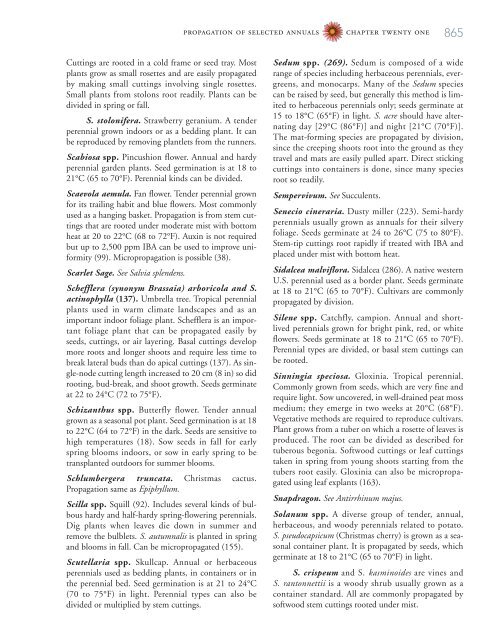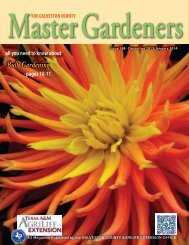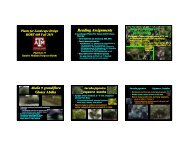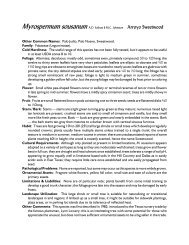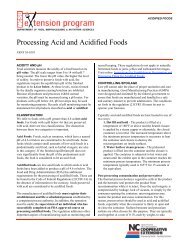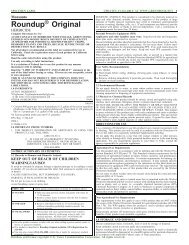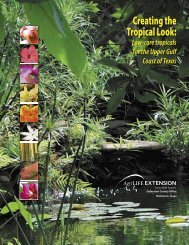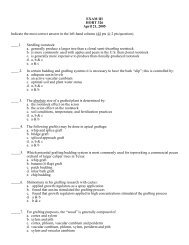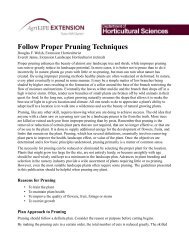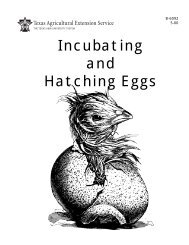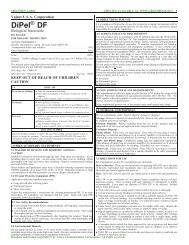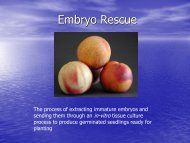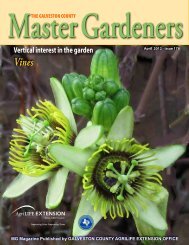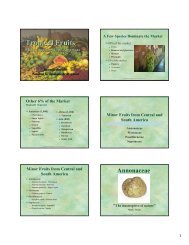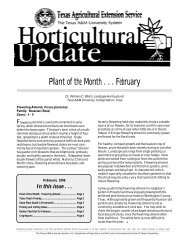Propagation of Selected Annuals and ... - Aggie Horticulture
Propagation of Selected Annuals and ... - Aggie Horticulture
Propagation of Selected Annuals and ... - Aggie Horticulture
You also want an ePaper? Increase the reach of your titles
YUMPU automatically turns print PDFs into web optimized ePapers that Google loves.
M21_DAVI4493_08_SE_C21.qxd 8/19/10 8:34 PM Page 865<br />
Cuttings are rooted in a cold frame or seed tray. Most<br />
plants grow as small rosettes <strong>and</strong> are easily propagated<br />
by making small cuttings involving single rosettes.<br />
Small plants from stolons root readily. Plants can be<br />
divided in spring or fall.<br />
S. stolonifera. Strawberry geranium. A tender<br />
perennial grown indoors or as a bedding plant. It can<br />
be reproduced by removing plantlets from the runners.<br />
Scabiosa spp. Pincushion flower. Annual <strong>and</strong> hardy<br />
perennial garden plants. Seed germination is at 18 to<br />
21°C (65 to 70°F). Perennial kinds can be divided.<br />
Scaevola aemula. Fan flower. Tender perennial grown<br />
for its trailing habit <strong>and</strong> blue flowers. Most commonly<br />
used as a hanging basket. <strong>Propagation</strong> is from stem cuttings<br />
that are rooted under moderate mist with bottom<br />
heat at 20 to 22°C (68 to 72°F). Auxin is not required<br />
but up to 2,500 ppm IBA can be used to improve uniformity<br />
(99). Micropropagation is possible (38).<br />
Scarlet Sage. See Salvia splendens.<br />
Schefflera (synonym Brassaia) arboricola <strong>and</strong> S.<br />
actinophylla (137). Umbrella tree. Tropical perennial<br />
plants used in warm climate l<strong>and</strong>scapes <strong>and</strong> as an<br />
important indoor foliage plant. Schefflera is an important<br />
foliage plant that can be propagated easily by<br />
seeds, cuttings, or air layering. Basal cuttings develop<br />
more roots <strong>and</strong> longer shoots <strong>and</strong> require less time to<br />
break lateral buds than do apical cuttings (137). As single-node<br />
cutting length increased to 20 cm (8 in) so did<br />
rooting, bud-break, <strong>and</strong> shoot growth. Seeds germinate<br />
at 22 to 24°C (72 to 75°F).<br />
Schizanthus spp. Butterfly flower. Tender annual<br />
grown as a seasonal pot plant. Seed germination is at 18<br />
to 22°C (64 to 72°F) in the dark. Seeds are sensitive to<br />
high temperatures (18). Sow seeds in fall for early<br />
spring blooms indoors, or sow in early spring to be<br />
transplanted outdoors for summer blooms.<br />
Schlumbergera truncata. Christmas cactus.<br />
<strong>Propagation</strong> same as Epiphyllum.<br />
Scilla spp. Squill (92). Includes several kinds <strong>of</strong> bulbous<br />
hardy <strong>and</strong> half-hardy spring-flowering perennials.<br />
Dig plants when leaves die down in summer <strong>and</strong><br />
remove the bulblets. S. autumnalis is planted in spring<br />
<strong>and</strong> blooms in fall. Can be micropropagated (155).<br />
Scutellaria spp. Skullcap. Annual or herbaceous<br />
perennials used as bedding plants, in containers or in<br />
the perennial bed. Seed germination is at 21 to 24°C<br />
(70 to 75°F) in light. Perennial types can also be<br />
divided or multiplied by stem cuttings.<br />
propagation <strong>of</strong> selected annuals chapter twenty one 865<br />
Sedum spp. (269). Sedum is composed <strong>of</strong> a wide<br />
range <strong>of</strong> species including herbaceous perennials, evergreens,<br />
<strong>and</strong> monocarps. Many <strong>of</strong> the Sedum species<br />
can be raised by seed, but generally this method is limited<br />
to herbaceous perennials only; seeds germinate at<br />
15 to 18°C (65°F) in light. S. acre should have alternating<br />
day [29°C (86°F)] <strong>and</strong> night [21°C (70°F)].<br />
The mat-forming species are propagated by division,<br />
since the creeping shoots root into the ground as they<br />
travel <strong>and</strong> mats are easily pulled apart. Direct sticking<br />
cuttings into containers is done, since many species<br />
root so readily.<br />
Sempervivum. See Succulents.<br />
Senecio cineraria. Dusty miller (223). Semi-hardy<br />
perennials usually grown as annuals for their silvery<br />
foliage. Seeds germinate at 24 to 26°C (75 to 80°F).<br />
Stem-tip cuttings root rapidly if treated with IBA <strong>and</strong><br />
placed under mist with bottom heat.<br />
Sidalcea malviflora. Sidalcea (286). A native western<br />
U.S. perennial used as a border plant. Seeds germinate<br />
at 18 to 21°C (65 to 70°F). Cultivars are commonly<br />
propagated by division.<br />
Silene spp. Catchfly, campion. Annual <strong>and</strong> shortlived<br />
perennials grown for bright pink, red, or white<br />
flowers. Seeds germinate at 18 to 21°C (65 to 70°F).<br />
Perennial types are divided, or basal stem cuttings can<br />
be rooted.<br />
Sinningia speciosa. Gloxinia. Tropical perennial.<br />
Commonly grown from seeds, which are very fine <strong>and</strong><br />
require light. Sow uncovered, in well-drained peat moss<br />
medium; they emerge in two weeks at 20°C (68°F).<br />
Vegetative methods are required to reproduce cultivars.<br />
Plant grows from a tuber on which a rosette <strong>of</strong> leaves is<br />
produced. The root can be divided as described for<br />
tuberous begonia. S<strong>of</strong>twood cuttings or leaf cuttings<br />
taken in spring from young shoots starting from the<br />
tubers root easily. Gloxinia can also be micropropagated<br />
using leaf explants (163).<br />
Snapdragon. See Antirrhinum majus.<br />
Solanum spp. A diverse group <strong>of</strong> tender, annual,<br />
herbaceous, <strong>and</strong> woody perennials related to potato.<br />
S. pseudocapsicum (Christmas cherry) is grown as a seasonal<br />
container plant. It is propagated by seeds, which<br />
germinate at 18 to 21°C (65 to 70°F) in light.<br />
S. crispeum <strong>and</strong> S. kasminoides are vines <strong>and</strong><br />
S. rantonnettii is a woody shrub usually grown as a<br />
container st<strong>and</strong>ard. All are commonly propagated by<br />
s<strong>of</strong>twood stem cuttings rooted under mist.


